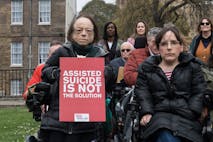
Disability rights groups file lawsuit to stop Delaware assisted suicide law
Angeline Tan
·
Studies: Over half of women seeking abortion are using birth control
The findings of two separate studies are pointing out the error in believing that access to birth control will allow women to avoid abortion. A study published by the Guttmacher Institute, along with a study by the British Pregnancy Advisory Service, found that more than half of the women who seek abortion reported using birth control during the same month they got pregnant.
The Guttmacher findings, published on January 8, 2018, state that in 2014, 51 percent of the women who sought abortion were using birth control. Of that 51 percent, 24 percent were using condoms, 13 percent were using the pill and one percent were using a long-acting reversible birth control such as an IUD.
The results of the British Pregnancy Advisory Service study published in July 2017, showed that 51.2 percent of women who sought abortion in 2016 were using at least one form of contraception when they became pregnant. 24.2 percent of those women reported using a hormonal method of birth control including the pill, patches, rings, injectable birth control, or implanted birth control. These methods are considered to be the most effective at preventing pregnancy.
Abortion industry businesses such as Planned Parenthood are working hard to gain access to younger and younger children in order to indoctrinate them in so-called sexual freedom. They actively work to create a relationship of trust and convince children to turn to Planned Parenthood rather than their own parents. Once trust is established, preteens and teens believe Planned Parenthood when they tell them that birth control will provide them with safe sex. Then, when these teens become pregnant, they are shocked and confused and turn to Planned Parenthood for help. Planned Parenthood then convinces these young people that abortion will solve their problem. Abortion happens to be the service that brings in the most money. Worse yet, it is expensive late-term abortions that women on birth control end up paying for because the effects of hormonal birth control make it difficult for women to believe they are – or physically feel that they are – pregnant. Here’s what happens in a second trimester abortion, as explained by former abortionist Dr. Anthony Levatino:
Article continues below
Dear Reader,
Have you ever wanted to share the miracle of human development with little ones? Live Action is proud to present the "Baby Olivia" board book, which presents the content of Live Action's "Baby Olivia" fetal development video in a fun, new format. It's perfect for helping little minds understand the complex and beautiful process of human development in the womb.
Receive our brand new Baby Olivia board book when you give a one-time gift of $30 or more (or begin a new monthly gift of $15 or more).

“Hormonal contraception can cause side effects which may mask the symptoms of pregnancy, including suppressing menstrual bleeding completely, or causing irregular or light periods,” reads the BPAS report. “Women using a method of contraception may also not identify their pregnancy at an earlier stage because they, unlike those not using any method of contraception, had not anticipated falling pregnant.”
In a separate report by the BPAS, they surveyed 28 women who were seeking an abortion after 20 weeks gestation. 17 of the 28 women reported that they were seeking an abortion not because of a threat to their health or a problem with the baby, but because they failed to realize they were pregnant until that point. That’s nearly 61 percent of those women seeking late-term abortions. Six of those 17 women were on the pill and one of those women was also using condoms. One woman was using a long-lasting implanted birth control. These hormonal birth controls simply didn’t allow women to see changes in their own bodies to the point that they were unable to realize they were pregnant.
Birth control has a failure rate that few pro-abortion groups are willing to admit to and it prevents women from realizing they are pregnant often until they are well into the second trimester.
Planned Parenthood boasts that it provides 1.8 million women with reversible hormonal birth control… but how many of them will return for an abortion?
Live Action News is pro-life news and commentary from a pro-life perspective.
Contact editor@liveaction.org for questions, corrections, or if you are seeking permission to reprint any Live Action News content.
Guest Articles: To submit a guest article to Live Action News, email editor@liveaction.org with an attached Word document of 800-1000 words. Please also attach any photos relevant to your submission if applicable. If your submission is accepted for publication, you will be notified within three weeks. Guest articles are not compensated (see our Open License Agreement). Thank you for your interest in Live Action News!

Angeline Tan
·
Politics
Bridget Sielicki
·
Issues
Sheena Rodriguez
·
Guest Column
Right to Life UK
·
Issues
Bridget Sielicki
·
International
Cassy Cooke
·
Human Interest
Nancy Flanders
·
Investigative
Nancy Flanders
·
Pop Culture
Nancy Flanders
·
Human Interest
Nancy Flanders
·
Human Interest
Nancy Flanders
·